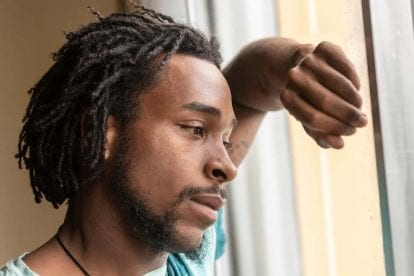Healing Mind, Body, and Spirit: Integrating Yoga into PTSD Treatment

In recent years, the medical community has increasingly become aware of the benefits of yoga on psychological health. However, yogic practice for mental balance is not new; in fact, it originated as a spiritual practice centered around “an ideal state of psychophysiological health and optimal function of body and mind in support of contemplative states of consciousness.” Far from being touted as a path toward slim thighs and amazing abs, yoga has historically been a practice devoted to the creation of inner harmony and release from emotional distress.
Now, yoga is being used as part of Post-Traumatic Stress Disorder (PTSD) treatment for people who have experienced physical violence, sexual assault, or combat trauma.
Toward Unification of Mind, Body, and Spirit
Because both trauma and PTSD symptoms are often overwhelmingly physical experiences, it makes perfect sense to engage in physical practice as part of the healing process. As Dr. Bessel van der Kolk, Professor of Psychiatry at the Boston University School of Medicine, says, “The memory of the trauma is imprinted on the human organism. I don’t think you can overcome it unless you learn to have a friendly relationship with your body.” Yoga is built around a series of breathing patterns and body postures designed to create a union of the body, mind, and spirit, and encourage that friendly relationship. With a wide range of diverse and flexible practices, virtually anyone can engage in yoga, making it an ideal therapy for people of all skill levels and abilities. While it produces the typical emotional and physical benefits of exercise such as decreased cortisol levels, enhanced sleep quality, and increased endorphin release, it also specifically seeks to nurture the mind-body connection that PTSD disrupts. Through mindful breathing and body movements, your ability to regulate heightened fight-or flight responses and other physiological anxiety symptoms is enhanced, restoring a sense of control and balance after trauma.
Begin Your Recovery Journey.
877-727-4343Yoga After Physical and Sexual Assault
Sara knows all about the grounding, bodily awareness, and enhanced sense of control yoga can create. Her practice isn’t a way to de-stress after a busy week at work or drop a few pounds. Instead, it is an integral part of her journey as a physical and sexual assault survivor living with PTSD who now suffers from flashbacks from the abuse suffered at the hands of her ex-husband. She uses yoga to rebuild her relationship with her body and her ability to be present in the moment. In “It is very difficult to stay in your own body when you’re getting flashbacks,“ she says in an interview with Yoga Journal, but yoga is helping her through it. It is also helping her get through the court appearances she must make each time her abuser violates the restraining disorder. “I realized that I’m a very strong person. Yoga reminds me that if I just keep plodding along, I can get there.”
For some sexual assault survivors in particular, yoga can be an intimidating prospect, especially if you are asked to engage in poses that make you feel vulnerable, exposed, or unsafe. Some movements may even be triggering. It is critical that you work within a supportive space that recognizes your emotional needs, allows you to practice in a way that is comfortable to you, and honors your history while facilitating healing. In a powerful essay for The Breathe Network, Molly Boeder Harris, a yoga instructor specializing in trauma-informed practice, writes, “Yoga allows survivors to incrementally regain a sense of comfort and ease within their own shape, to non-verbally process feelings that transcend language and to experientially cultivate gratitude towards the body.” This is where the healing process begins–in the reframing of physicality, the somatic expression of emotion, and integration of mind, body, and spirit.
Recovering From Combat-Related PTSD
Assault survivors aren’t the only ones finding strength through yogic practice. A study published in the Journal of Traumatic Stress last year confirmed the benefits of breathing-based yogic meditation and was the first randomized, controlled study of its kind to offer methodologically sound support for its implementation in PTSD treatment for war veterans. The researchers studied the effects of sudarshan kriya yoga on a group of 21 American veterans who had served in either Iraq or Afghanistan and suffered from PTSD. The veterans who participated in yoga “demonstrated fewer and less intense PTSD symptoms,” including “lower anxiety and respiration rates,” better emotional regulation, and decreased impact of intrusive memories.
One of the warriors who has experienced the benefits of yoga is Air Force veteran Chris Eder, who turned to yogic practice after two tours in Iraq left him with crippling PTSD that kept him locked in a state of hypervigilance. “I do not know where I would be without my yoga and meditation practice,” he says. That’s not entirely true; he suspects that without yoga, he could easily be one of the “estimated 22 U.S. veterans who take their own lives every day.” While some men are initially reluctant to try yoga, Eder says that once they try it, they quickly become converts, opening up a new avenue for meaningful healing. By rebuilding your relationship with your physical self, learning how to both listen to and control bodily responses, and understanding the connection between emotional and somatic states, you can improve your ability to cope with traumatic experiences in a healthy and productive way.
Call for a Free Confidential Assessment.
877-727-4343Yoga at Bridges to Recovery
Incorporating yoga in a comprehensive PTSD treatment program can offer powerful and lasting benefits for survivors of trauma. At Bridges to Recovery, we offer yoga to all of our clients to enhance bodily awareness, emotional growth, self-regulation, and inner tranquility. Our instructors support each individual in engaging in movements, breathing patterns, and mindfulness practices that are safe and comfortable for them and can tailor sessions to address the specific needs of each client. When combined with other evidence-based treatment modalities within a holistic, multidisciplinary program, we believe that yogic practice can deeply enrich the lives of people living with mental health disorders in general and PTSD in particular.
Bridges to Recovery offers innovative, holistic treatment for people living with PTSD. Contact us today for more information about our program, facilities, and how we can help you or your loved one on the journey towards healing.






